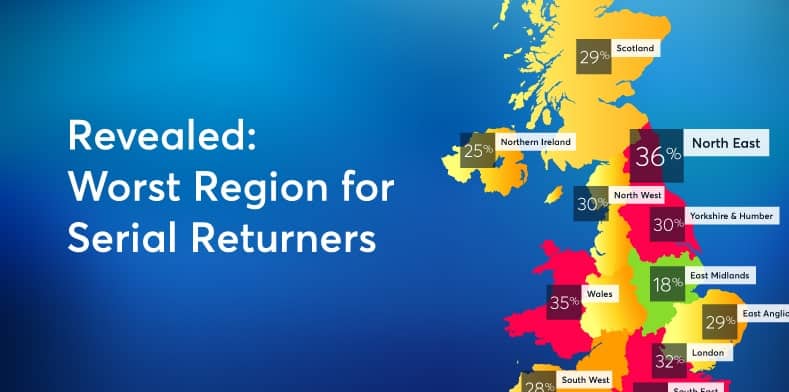Retailers like you are already under intense pressure, from reduced margins to competition from online giants, and now you face another woe: the rise of the so-called “serial returners”, who deliberately buy more items than they intend to keep and return them days later.
We recently surveyed 4,000 consumers across the UK and found that the North East is the worst region for ‘serial returners’, a trend that is costing retailers £7bn a year.
Our research reveals that 36% of all shoppers in the North East admit to buying multiple items with the intention of returning some – making them the worse serial returners in Britain.
To recap, here are the top ten worst regions for “serial returners” in the UK:
- North East (36%)
- Wales (35%)
- South East (33%)
- London (32%)
- North West (30%)
- Yorkshire & Humber (30%)
- East Anglia (29%)
- Scotland (29%)
- South West (28%)
- Northern Ireland (25%)
What does this mean for you and other retailers?
While the North East tops the list with the most serial returners, it’s an emerging issue that all merchants, across the country, must look to address.
40% of retailers told us they’ve noticed a marked increase in serial returns over the past year, and more than half of retailers (52%) are seeing their profits severely impacted by the process of managing these returns.
Our findings also show that more than half of all 18-24 year olds intentionally return items they’ve bought, and with that generation’s buying power increasing year-on-year, it’s only a matter of time before serial returner behavior becomes the norm.
Online shopping has fueled the rise of the serial returner, alongside generous return policies. It comes as no surprise then that online retailers are hit harder, with 30% of all products ordered online being returned. This lost revenue is worth £7bn for retailers, with sales coming in that they ultimately cannot recognize.
It’s clear that the nationwide escalating returns issue should be of major concern to you and other retailers and something must be done, urgently. There’s some evidence that retailers are beginning to act to recoup return costs in order to protect the bottom line. For example, 46.7% of (US) retailers now say they charge for ecommerce returns in 2018, up from 39.1% the year before.
That is one option, but doesn’t sit right, and is at odds with the demands of customers. Our study found that 85% of consumers expect retailers to provide returns for free. While offering free returns is resulting in a loss of revenue, it’s arguably key to your customer experience strategy.
Nevertheless, you must find a means of effectively tackling the growing issue of returns.
Using technology to combat the rise in “serial returns”
Figures from our research show that over two-thirds (69%) of retailers do not use any technology to manage returns. This is a clear missed opportunity.
Having the right warehouse systems and technology in place can help you to optimize the returns process and meet the challenge of serial returners. For example, using technology to centralize your returns data is one way to quickly identify serial returners and helps to put you in a much more informed position where you can make decisions on how you can weed out these problematic shoppers.
In addition, the logistical and financial implications of handling rising volumes of returns and the impact on return rates means that flexible warehouse systems should be considered a priority, so that you’re able to meet your consumers’ rising expectations of seamless and free returns while at the same time also protecting your bottom line.
For a deeper look at these “serial returner” figures and other key insights, take a look at our research report now.
This article originally appeared in Retail Sector.






